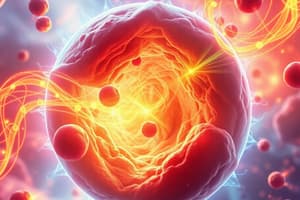Podcast
Questions and Answers
What is the result of eating fewer calories than burning?
What is the result of eating fewer calories than burning?
- Weight gain
- Increased muscle mass
- Weight loss (correct)
- No change in weight
What is the majority of energy expenditure comprised of?
What is the majority of energy expenditure comprised of?
- Exercise activity thermogenesis (EAT)
- Thermic effect of food (TEF)
- Basal metabolic rate (BMR) (correct)
- Non-exercise activity thermogenesis (NEAT)
What is the purpose of non-exercise activity thermogenesis (NEAT)?
What is the purpose of non-exercise activity thermogenesis (NEAT)?
- Voluntary physical activity
- Digestion and storage of food
- Purposeful exercise
- Spontaneous movement (correct)
What is the definition of resting energy expenditure (RER)?
What is the definition of resting energy expenditure (RER)?
What is a MET?
What is a MET?
What is the energy cost required for digestion, absorption, and storage?
What is the energy cost required for digestion, absorption, and storage?
What is the characteristic of obesity?
What is the characteristic of obesity?
What is the limitation of using BMI to measure obesity?
What is the limitation of using BMI to measure obesity?
What happens to BMR when caloric intake increases?
What happens to BMR when caloric intake increases?
Flashcards are hidden until you start studying



